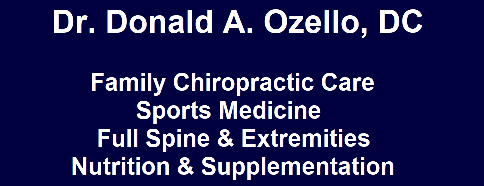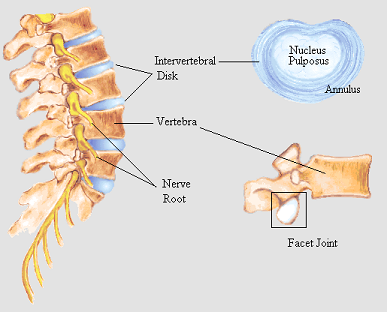Chiropractic treatment is effective for a wide range of conditions including a bulging intervertebral disc and a herniated intervertebral disc.
Chiropractic care is drug-free, surgery-free functional medicine. The primary objective of Chiropractic treatment is to restore proper skeletal motion and optimize nerve flow to maximize the body’s healing capabilities.
Doctors of Chiropractic use a procedure called the chiropractic adjustment or manipulation. The chiropractic adjustment is a high velocity, low-amplitude, focused thrust that re-establishes proper motion to a joint and lessens nerve impingement. Chiropractic adjustments can be utilized on any joint in the body but are most commonly used to treat the spine.
The adult human spinal column consists of twenty-four articulating vertebra plus nine fused vertebrae in the sacrum and coccyx. Intervertebral discs, or disks, are located between the individual vertebra, hence the name intervertebral disc. The discs function to distribute shock throughout the vertebra.
The intervertebral disc has a strong outer fibrous ring-like covering named the annulus fibrosus which surrounds a gel-like filled center called the nucleus pulposes. Visualize the intervertebral disc as a small, tough jelly donut.
A disc bulge occurs when the nucleus pulposes pushes the outer layer outward. Thus, the outer layer bulges outward. This can happen over a broad area or in one distinct place. A disc can bulge in any direction but most commonly discs bulge directly backwards toward the spinal cord or backwards and lateral into the opening between the vertebra called the intervertebral foramen.
A disc herniation occurs when the nucleus pulposes breaks through the outer layer. Thus, the inner portion of the disc protrudes through the outer portion. A herniated disc commonly occurs in a distinct spot. The most common direction of a disc herniation is backwards and sideways into the intervertebral foramen.
The non-medical term slipped disc is often used for both bulging and herniated disc. This outdated general term causes confusion and will not be used in this article.
The non-medical term ruptured disc is often used when referring to a herniated disc. This generic term will not be used in this article.
A disc bulge or herniation can occur in the neck, middle back or lower back. In medical terms, these spinal areas are named the cervical spine, thoracic spine and lumbar spine respectively.
The direction and size of the disc bulge or herniation are important factors in the occurrence and intensity of symptoms. Many disc bulges and herniations are silent, meaning they elicit no symptoms or limitations in movement. A small percentage of bulging or herniated discs produce unrelenting, unbearable symptoms.
When symptoms of a bulging or herniated disc occur the most common include sharp-shooting pain, burning pain, numbness, tingling, weakness, fatigue, muscle spasms and limited pain-free motion.
A bulging or herniated disc can be seen on an MRI. A disc bulge and a disc herniation cannot be viewed on an x-ray. A reduction in the space between the vertebra, or disc space, can be seen on x-ray. Reduced disc space does not mean a disc bulge or herniation exists.
A disc bulge or herniation can produce symptoms because it can place pressure on a nerve. The most common direction of a disc bulge or herniation is backwards and lateral into the intervertebral foramen.
Immediately after branching off the spinal cord the spinal nerve root passes through the intervertebral foramen. If a disc bulge or disc herniation is large enough it may place pressure on the spinal nerve. This pressure may elicit symptoms along the course of the nerve.
Chiropractic care re-establishes correct spinal motion. When a vertebra is moving properly it restores the correct amount of space in the intervertebral foramen and alleviates the pressure a disc bulge or herniation places on the spinal nerve root. The release of pressure on the nerve helps reduce the symptoms.
Chiropractic helps eliminate the source of the symptoms and the symptoms. Restoring the correct skeletal motion opens the joint space thus eliminating the source of the impingement the disc bulge or herniation places on the nerve. The removal of the nerve impingement reduces the symptoms.
Patient education is essential for those with bulging or herniated discs. Many times, the symptoms reoccur due to an accumulation of extrinsic factors over time or from a single incident. Proper lifting, correct workstation ergonomics, strengthening exercises, stretching exercises and sound nutritional strategies help the patient prevent or lessen the frequency and intensity of recurrences.
Chiropractic treatment is a proven, conservative, natural approach to healing and restoring health and functionality. The restoration of proper skeletal motion and the optimization of nerve flow combined with patient education should help those with a disc bulge or herniation.
Dr Donald A Ozello DC of Championship Chiropractic in Las Vegas, NV
Web Site: http://www.championshipchiropractic.com/
Blog: https://www.championshipchiropractic.com/wordpress/
YouTube: https://www.youtube.com/user/drdozellodc/videos
Twitter: https://twitter.com/drdozellodc
Facebook: https://www.facebook.com/Championship-Chiropractic-280141628688300/
LinkedIn: https://www.linkedin.com/in/dr-donald-a-ozello-dc-716b3233
“Running: Maximize Performance & Minimize Injuries” https://www.amazon.com/Running-Performance-Chiropractors-Minimizing-Potential/dp/1493618741
**Disclaimer: Always consult a medical professional before beginning an exercise program. Always work within your capabilities. Never perform an exercise that elicits or increases pain or symptoms. Reading this article and viewing the linked videos does not take the place of seeing a medical professional. Please visit a medical professional for evaluation, diagnosis & treatment.


Would like to make an appointment. I have MRI results to show you. I was referred by my mother in law Sandy Jacques
Thanks for the message. I will contact you via email.